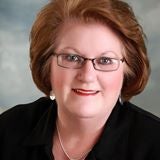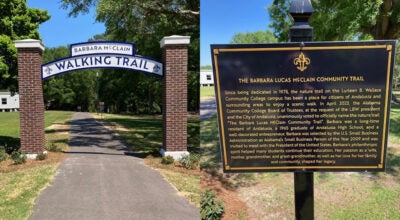Remember When: The Baptists’ bells
Published 1:03 am Saturday, June 4, 2016
“When they ring those golden bells for you and me!”
 In 1959 when the new First Baptist Church building was being built in the residential district on East Three-Notch Street, Deacon Speller Moates discussed with Deacon Leamon Cook, father of Donald Cook, as they stood on the steps of the old church building that was located directly behind the courthouse, the possibility of installing the old bell in the new church soon to be completed. Brother John Jeffers, pastor, and board of deacons chairman Henry Merrill joined them in their thinking. Merrill, a master builder, and Cook, a master carpenter, agreed that the idea was a good one and right feasible.
In 1959 when the new First Baptist Church building was being built in the residential district on East Three-Notch Street, Deacon Speller Moates discussed with Deacon Leamon Cook, father of Donald Cook, as they stood on the steps of the old church building that was located directly behind the courthouse, the possibility of installing the old bell in the new church soon to be completed. Brother John Jeffers, pastor, and board of deacons chairman Henry Merrill joined them in their thinking. Merrill, a master builder, and Cook, a master carpenter, agreed that the idea was a good one and right feasible.
The next day, they traded with the building foreman from Marion, Ala., to proceed to move the bell to the new steeple. $50 would be paid to him if the church members would take the old bell down and deliver it to the new site. So early one morning, Moates, Cook, and Merrill met to remove the old bell. It was required to unbolt it from the wooden stand, and carefully it was taken down from the vestibule ceiling using a block and tackle to lower it. This procedure took about an hour and a half.
Some days later, the deacons called a meeting (Does this sound familiar?) to decide how the bell in the new church should be rung – by rope as in the old church which was rung by a hired sexton or otherwise. “There is an art to it,” stated Moates. “Pull – give – pull. Let’s continue the old way!”
Joe Tipton, church member, deacon, and Auburn graduate of electrical engineering, suggested that they electrify the bell.
Moates recalls, “Well, that’s exactly what was decided on, but to our dismay, once the bell was installed to ring by electrical methods, it would ding but not dong! They all gave up and just didn’t use it for about a year or so after the move was made to the new church.”
Finally, Moates and Cook went up by way of the cat walk to determine what the problem was since so much effort had gone into the moving of the bell. They saw immediately that the tripod (what the bell hangs to) was up and down instead of crossways or horizontal causing the jack which operates the bell to work improperly. They fastened an arm to the bell brackets and put some weights from a junkyard to offset the balance.
In telling this story to this writer many years ago, Moates proudly stated that “even today there is still a noticeable difference in the dings and the dongs but not to the average listener!”
Moates described the bell as 18” – 24” tall and wide weighing 300 to 400 pounds. “Made of cast iron, it has a good tone but not as keen as the one in the old courthouse which was once located in the center of the Public Square. That one could be heard for 4 or 5 miles.”
Getting to the belfry is not an easy task today. Moates directed interested bell viewers “to climb straight up the approximately 20-step wall ladder located in the rear of the auditorium building across the cat walk situated above the ceiling and near the roof the full length of the auditorium up some more steps into the good-sized steeple room then to the extreme top.”
Moates kept the old bell rope and chain from the old church belfry for sentimental reasons but donated these items back to the church before his death. Wonder where they are now?
So some Sunday morning or evening if you readers are near the church, listen for the bell atop the First Baptist Church steeple and remember this story that was told to this writer, a friend and former Three Notch Court neighbor of Speller and Lois Moates.
The Andalusia Star, February 6, 1931 edition reads, “Rev. Wm. A. Sunday, famous evangelist, will deliver a lecture in the Baptist church at ten o’clock Friday morning. Mr. Sunday, known all over this country as ‘Billy’ Sunday, former professional baseball player, and for many years the most colorful figure on the evangelistic platform, is in Alabama for a number of engagements. He came to this state by invitation of Dr. Bob Jones whose fame as an evangelist lacks but little of equaling Mr. Sunday’s. Rev. J. A. Cook, pastor of the First Baptist Church is being aided by other ministers of the city in arranging for his lecture. A number of ushers have been selected from the several churches of the city, and all plans have been made for a great crowd. The opportunity of hearing this outstanding lecturer will not be passed up by people of Andalusia and this vicinity.”
“Billy” Sunday, born in 1862, had become the most celebrated and influential American evangelist during the first two decades of the 20th century. He was known for his “fire and brimstone” preaching style and had become an ordained preacher in the Presbyterian church after having been a popular outfielder in baseball’s National League during the 1880s.
Sunday was credited with being a major social influence in the temperance movement which led to Prohibition in 1919. One of his famous sermons was “Booze or Get on the Water Wagon.” He continued to preach against alcohol consumption until his death in 1935 in the depths of the Depression even after Prohibition was repealed.
In thinking of all of those stories that have been told to this writer about old times at the old Baptist church off the square, several humorous ones come to mind like this one told by Sidney Waits. The late Mrs. Miller, a quite accomplished soloist, was singing at one of those lovely formal weddings of the day. Before the time of florists and flower shops, families and friends of the bride would customarily decorate the sanctuary and altar with greenery and blooms from home gardens. During the wedding ceremony and right in the middle of Mrs. Miller’s highest note in “The Wedding Prayer,” (“…and when life’s sun shall set beyond the hill, may we walk hand in hand in hand together still.”) a hidden frog deep in the greenery croaked!
Another anecdote told by a living former church member who was reared in the FBC and baptized in 1939 reminisces, “Several of us junior age lads were awaiting our baptisms near the church baptistery. Wouldn’t it be a great idea, we thought, for us boys to get wet before Dr. Cook performed our actual baptisms? A brilliant idea indeed! Well, we did just that, but it did not thrill our parents and relatives in the congregation,” Richard Kearley, Jr. recalls. “When I got home, my embarrassed mother gave me a ‘whopping’ to remember!” Kearley, a long-time resident of Dallas, Texas, chuckled as he told this story. He hesitated to name his friend in the scheme who became one of Andalusia’s most prominent and civic-minded citizens. Kearley, who loves his home church, and his wife Clarice are credited with donating the grand piano and herald trumpets to First Baptist that have been used in worship services for a number of years. They also had a local artist, Laura Godwin, to paint an oil portrait of the old church where his faded memories are from time to time as clear as yesterday. This significant painting of the old church in all its glory built in 1909 and dedicated in 1914 hangs in the enclosed breezeway near the choir room entrance thanks to the Kearleys.
Guess a fitting conclusion to this article will be to note that this writer’s parents met on the front steps of the old Baptist church downtown during World War II in June of 1944. Lt. (j.g.) Charles C. Bass, a Navy pilot, was in Andalusia for the weekend with some other naval officers who would routinely drive up from Pensacola to date the prettiest girls in South Alabama, the Andalusia girls, the jitterbug queens!
Those Navy boys headquartered at The Gables on Church Street. Marjorie Brunson would look for the plane to fly real low over her father’s downtown bakery and tip its wings one way or the other signifying whether or not Bass would arrive that evening for a date. The town newspaper editor wrote, “Some young daredevil was flying a twin motor over town this week. Bet if he was at home his parents would hesitate to let him have the family car to drive.” The rest of that story is history!
A treasure of old photos and photo postcards are housed at the Three Notch Museum on Historic Central Street in downtown Andalusia. If you and your family decide to enjoy a “stay-cation” this summer, make plans to visit your hometown museum where the past meets the future!





